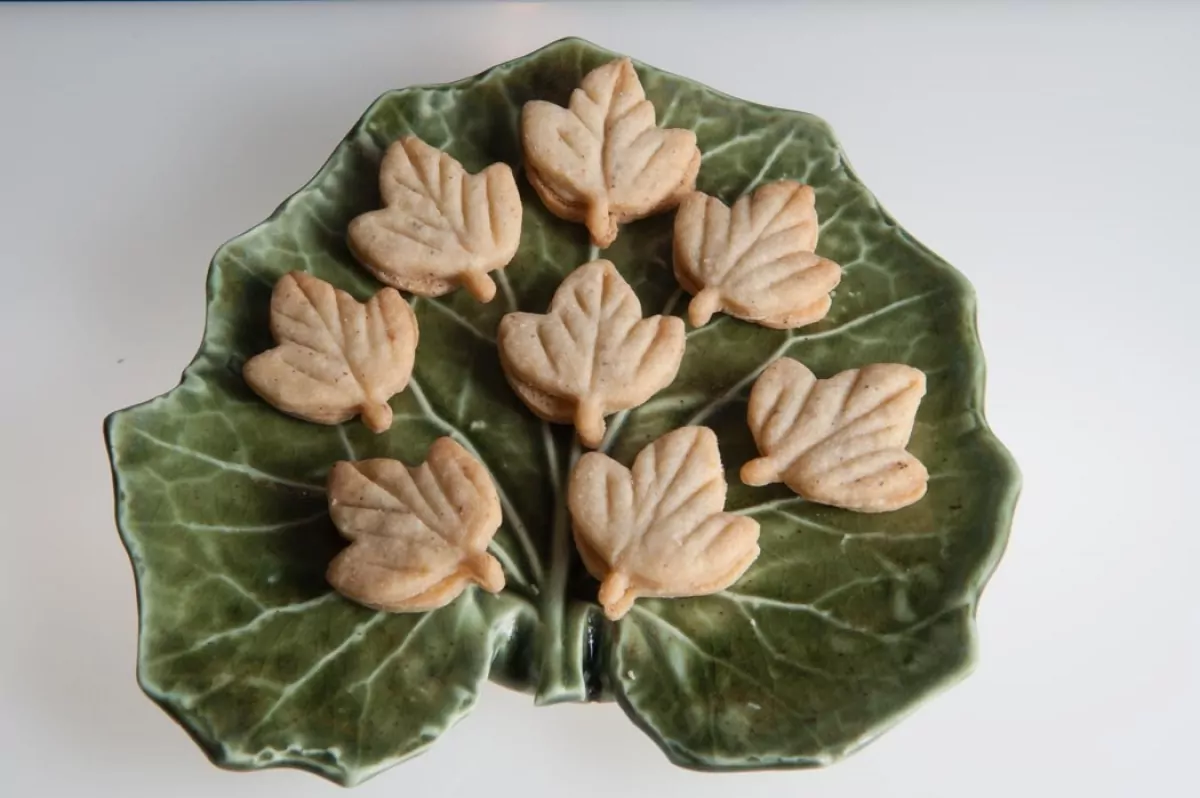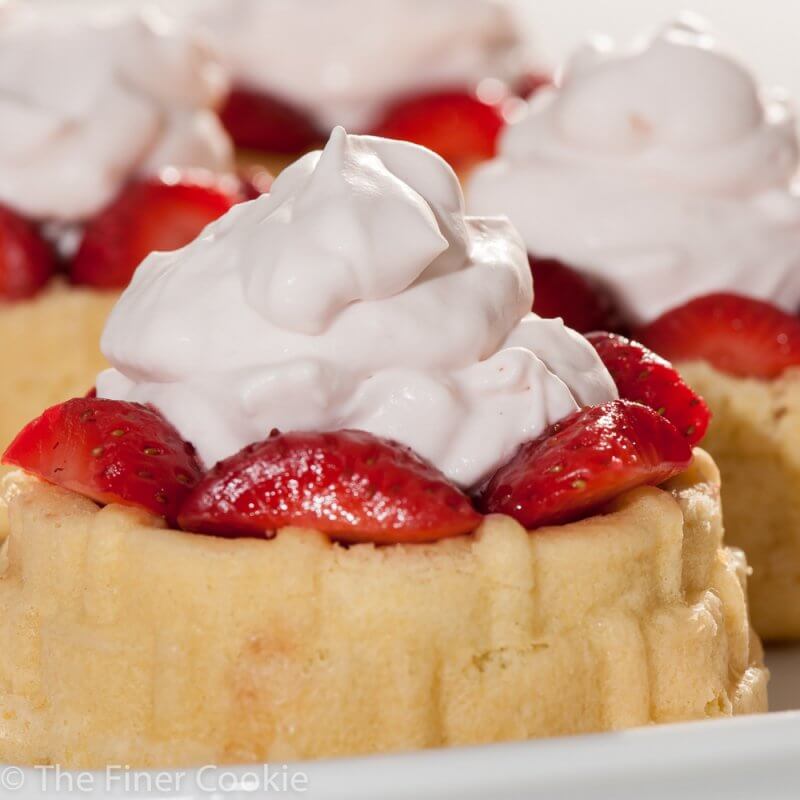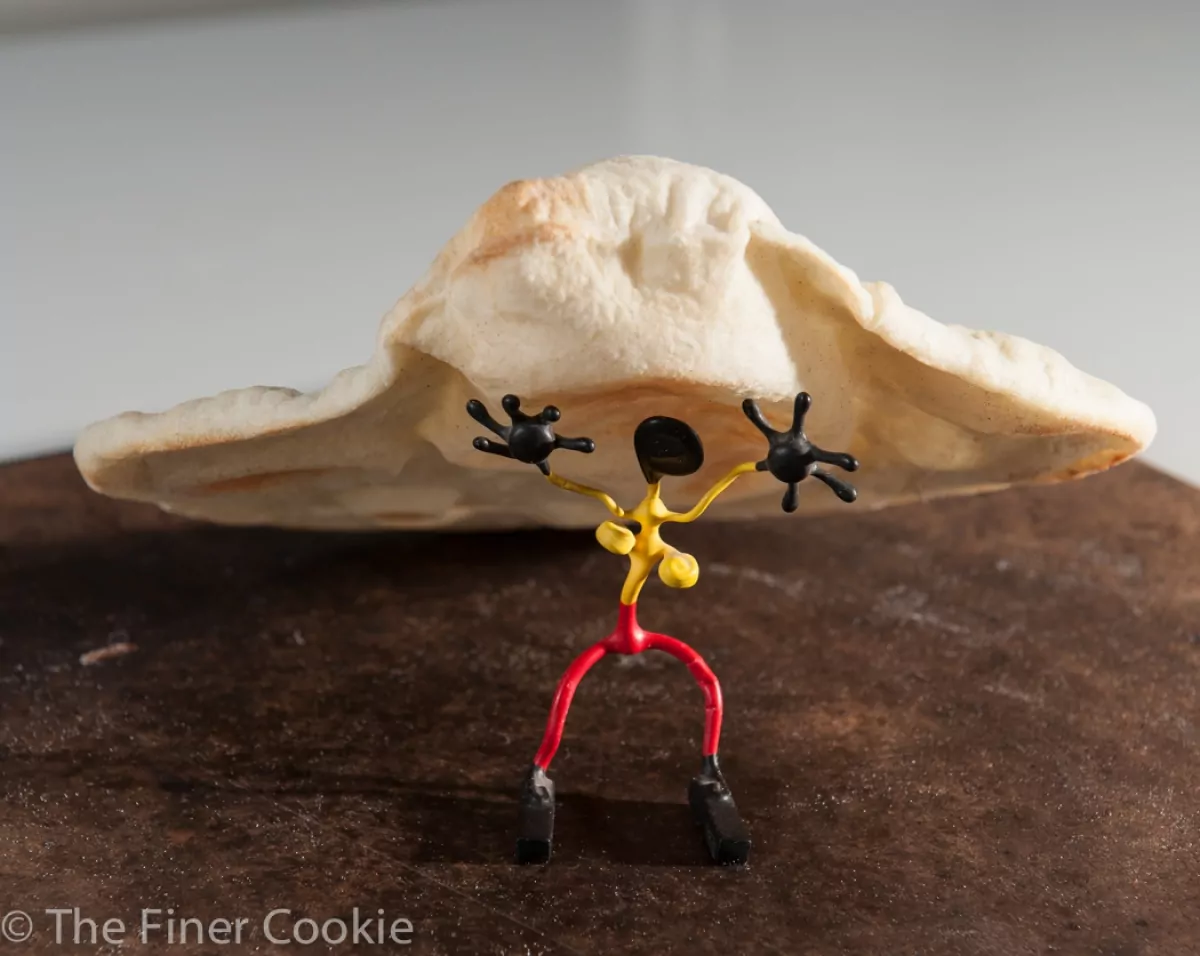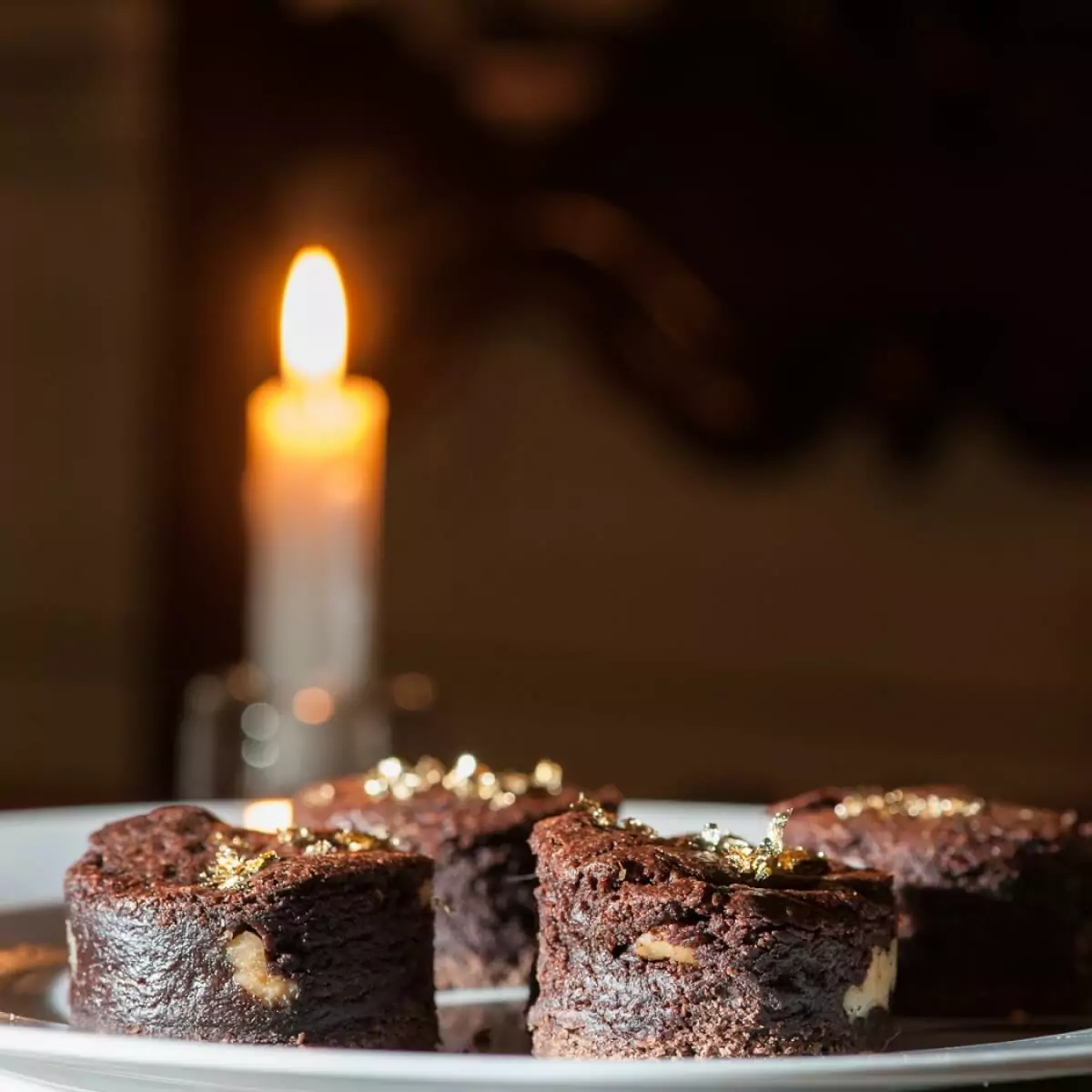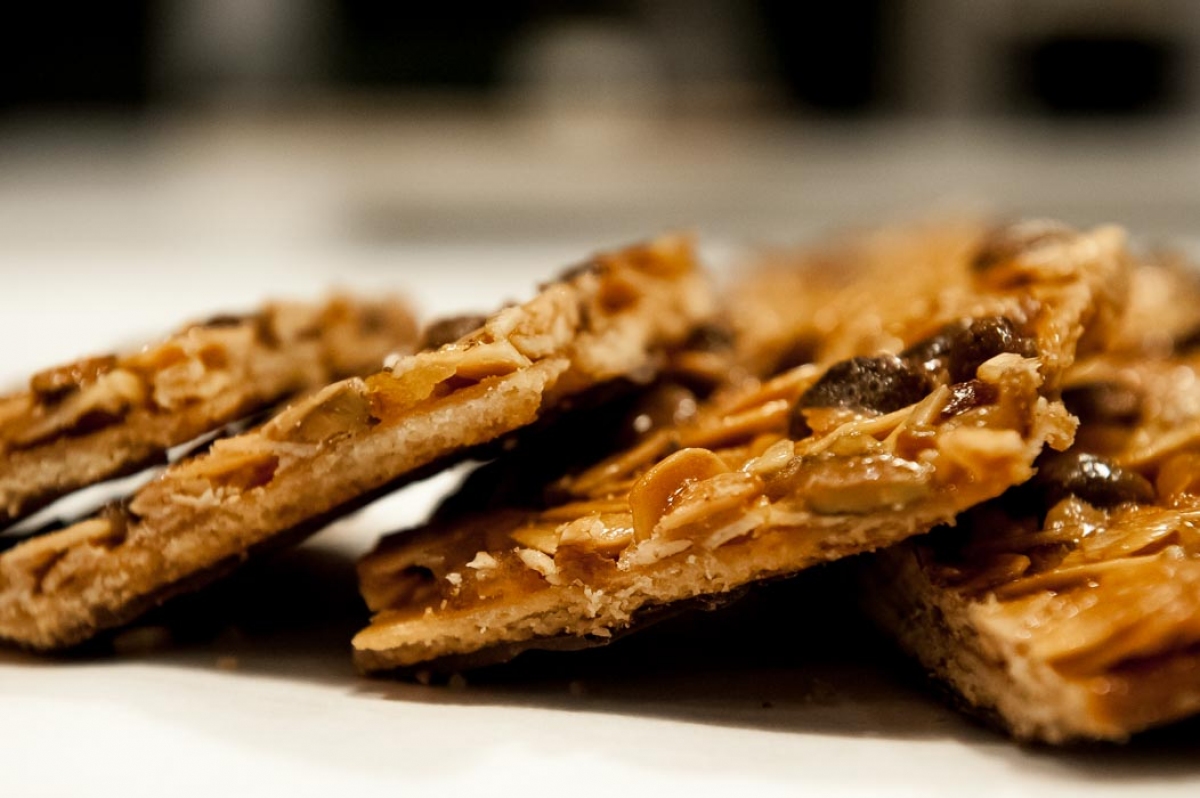
Florentines
November 24, 2014
When Florentines are in the room, your head and your heart dissolve into a milkshake of sorts, and the agreements you made with yourself disappear. You’ll feel no regrets when the chocolate goes liquid, and the soft tooth of the shortbread and nuts blend with the crispy caramel. Going nuts is a pleasure. Try this Florentine cookie recipe and let me know how you liked it.
The Finer Cookie is a participant in the Amazon Services LLC Associates Program, an affiliate advertising program designed to provide a means for websites to earn advertising fees by advertising and linking to amazon.com. This post contains affiliate links, which means The Finer Cookie will receive a small commission if you make a purchase using this link. This modest income helps support the website.
Ingredients
Candied Orange Peel
- 1.5 pounds 650 grams 1.5 ounces oranges
- 1 1/2 cups 300 grams 10.5 ounces granulated white sugar
- 1 1/2 tablespoons 30 grams 1 ounce corn syrup
Pâte Sucrée Ingredients
- 2¾ cups 375 grams 13.2 ounces bleached all-purpose flour
- 1/4 cup + 2½ tablespoon 46 grams 1.6 ounces powdered sugar
- 3/4 cup + 1 tablespoon 94 grams 3.3 ounces powdered sugar
- 1/4 cup + 3 tablespoons 47 grams 1.6 ounces almond meal
- 2 sticks 225 grams 8 ounces unsalted butter, room temperature
- ½ ½ ½ vanilla bean, split lengthwise
- 2 large 56 grams (about 2 large) 1.9 ounces (2 large) eggs
Nut and Fruit Layer Ingredients
- 3 tablespoons + 3/4 teaspoon 52 grams 1.8 ounces whole milk
- 1/4 cup + 2 1/2 tablespoons 79 grams 2.7 ounces white granulated sugar
- 2 tablespoons 42 grams 1.5 ounces glucose (see ingredient notes below)
- 2 tablespoons 42 grams 1.5 ounces clover honey
- 1/2 cup 105 grams 3.7 ounces unsalted butter, room temperature
- 1 pinch 1 pinch 1 pinch kosher salt
- 1 1/2 cups 126 grams 4.5 ounces blanched, untoasted sliced almonds
- 1/4 cup + 1 tablespoon 42 grams 1.5 ounces shelled raw unsalted, untoasted pistachios
- 3 tablespoons 42 grams 1.5 ounces candied orange peel (see recipe above)
- 1 1/4 cups 200 grams 7 ounces delicious chocolate 64%, melted

Instructions
CANDIED ORANGE PEEL
- This recipe will make more than you’ll need for these Florentines. Leftovers are wonderful in salads, on salmon, in oatmeal or yogurt, and pan sauces.
MIS-EN-PLACE FOR THE CANDIED ORANGE PEEL
- Cut the oranges in half and cut through the white pith (between the flesh and the rind). Save the flesh for another use. Cut and weigh the rinds.
- To read more about how mise en place can benefit you, see The Finer Cookie’s post on why everyone should Mise en Place.
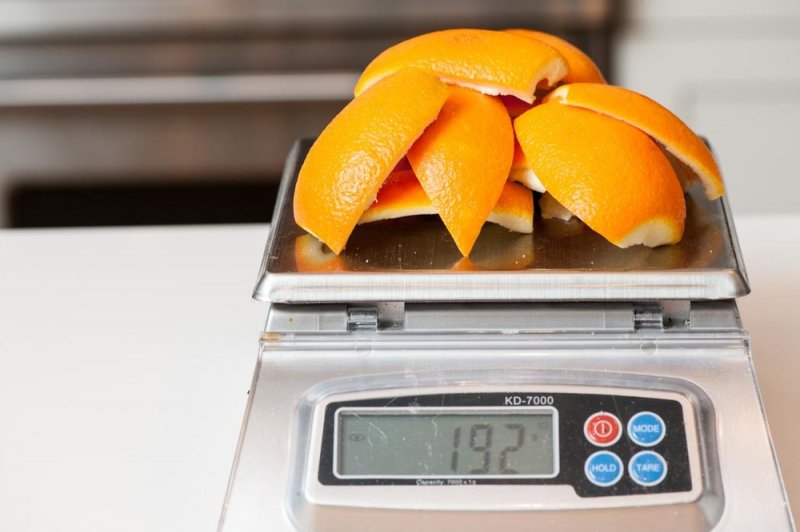
- Measure an equal weight of sugar.
- Add 10% of their weight in corn syrup
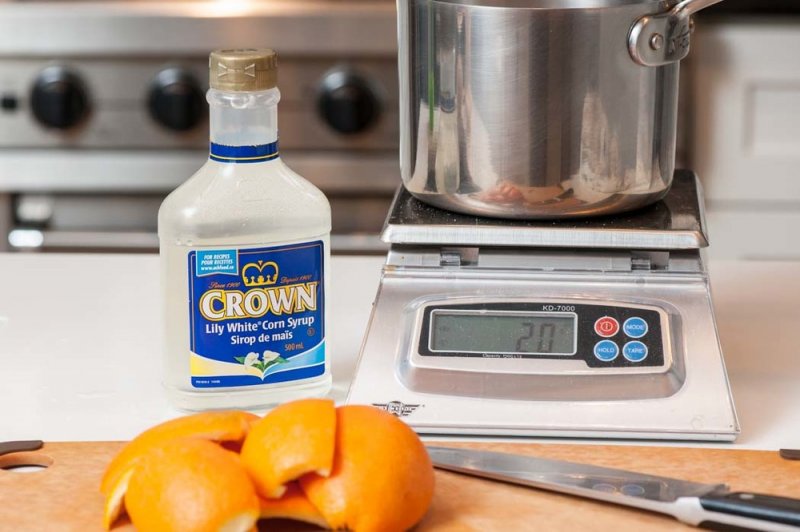
- Prepare the sugars in a small saucepan, and set aside.
- Cover the rinds, rounded side down, in a pot of cold water.
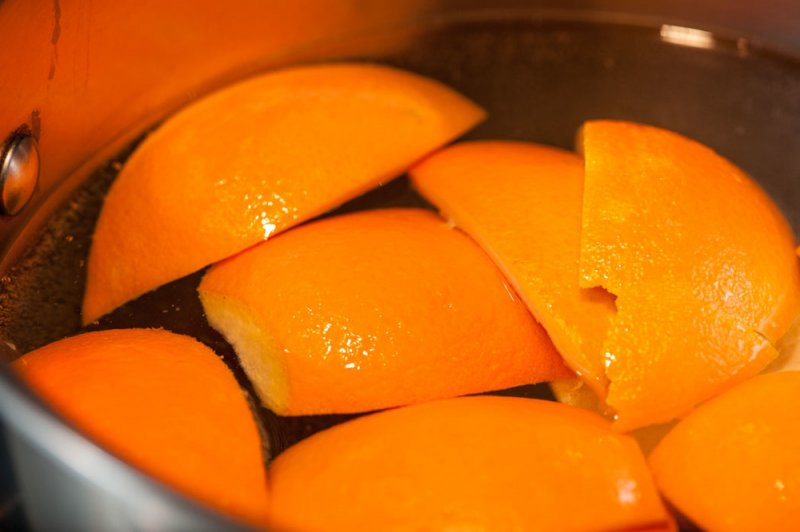
MAKING THE CANDIED ORANGE PEEL
- Bring the rinds to a simmer. Drain and rinse the two more times: blanche them three times total.
- Remove the excess pith.
- Cut the rinds into ¼ inch slices.
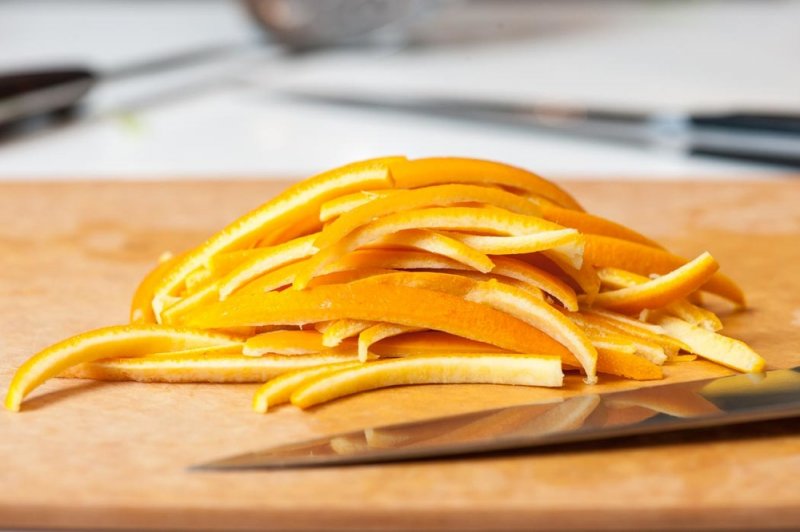
- When complete, add a little water to the sugars and heat, stirring to dissolve. Add the blanched, sliced rinds to the sugar mixture and add enough water to cover. Bring it to a gentle simmer, cover and cook for 1½ hours. They are done when the rinds are soft, but still hold their shape.
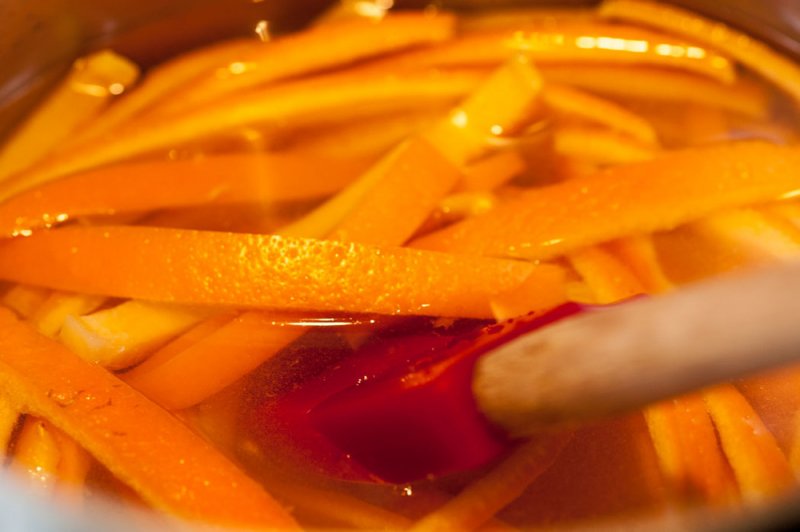
- Cool in the syrup and refrigerate overnight. If crystals form, place the peels and syrup in a saucepan and reheat until the crystals dissolve. The candied orange peels can be kept in the fridge for up to 2 months.
PÂTE SUCRÉE
- This particular recipe of Pâte Sucrée is one of my favourites because there isn’t a worry about keeping the butter cold. Since the butter starts out at room temperature, all the worry is gone. So kneading it with the heel of your hand becomes a very pleasurable experience. You have time to look at the pastry, feel it in your hands, and assemble it at a comfortable pace. The final shortbread will be tender and crispy. Enjoy making this pastry, since it’s one of the few versions that allow you the time to do so.
MIS-EN-PLACE FOR THE PÂTE SUCRÉE
- Weigh the all-purpose flour into a medium bowl.
- Sift 46 grams of powdered sugar and all the almond meal together. (Sifting the almond flour is important here because it breaks up the oils that cause the almond flour to clump).
- Add the sugar and almonds to the all-purpose flour.
- Measure the 94 grams of powdered sugar and set aside with a sifter or a sieve; Measure the room temperature butter in the bowl of a stand mixer and ready the flat beater. Split the vanilla bean in half and scrape the seeds. Set aside. See The Finer Cookie’s post about how to weigh and measure.
- Measure the egg and bring it to room temperature.
- Line your tray with a sheet of parchment paper, leaving an inch or two of paper along the length of the tray. You will need the extra length when it’s time to lift the Florentines out of the tray.
- Ready the pie weights or rice for blind baking the pastry.
ASSEMBLE THE PÂTE SUCRÉE
- Cream butter in the stand mixer on medium-low speed with a paddle attachment until it is a pommade—a term that simply means to warm/soften the butter until it is so soft that when creamed or whipped, it has the consistency of mayonnaise. It will hold a peak when the paddle is lifted. To get this texture, just warm the bowl over the flame or element on the stove for a few seconds at a time and cream the butter afterward. You will see the butter instantly transform and mound lusciously. Read more about how to cream butter and sugar here.
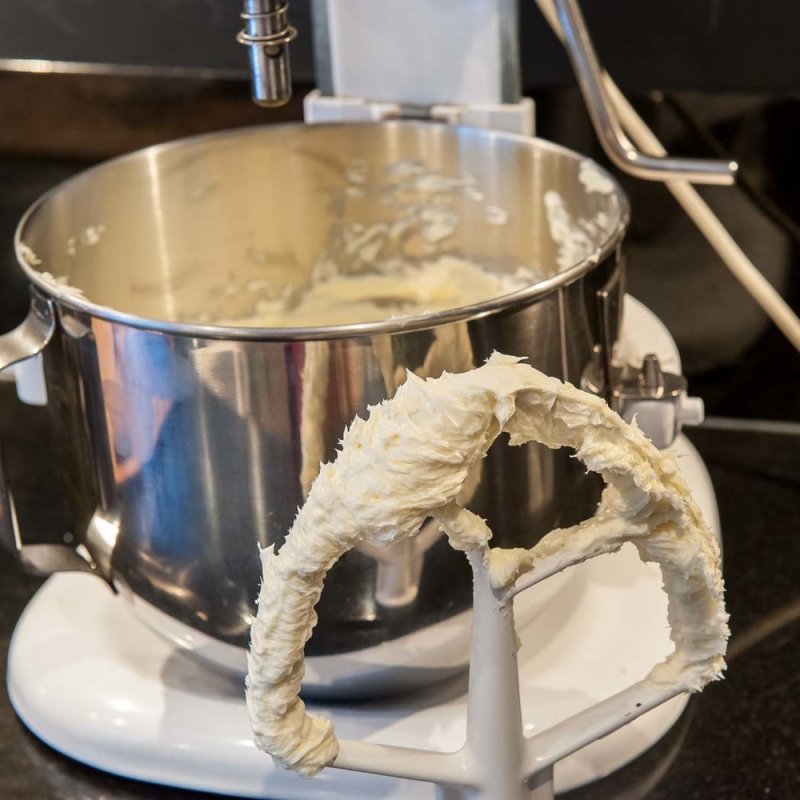
- Sift the remaining 94 grams of powdered sugar into the butter and pulse the stand mixer to incorporate the two, then increase the speed to medium-low for about 1 minute, until the mixture is fluffy. Add the vanilla seeds to the butter and scrape the mass away from the sides of the bowl. Stir on low speed until the seeds are incorporated evenly.
- Add the flour mixture to the butter in two additions, mixing for 15-20 seconds after each. Scrape the bottom of the bowl to ensure all the dry ingredients are incorporated and add the egg. Mix on low speed until combined.
- Transfer the crumbly dough mass to a clean work surface.
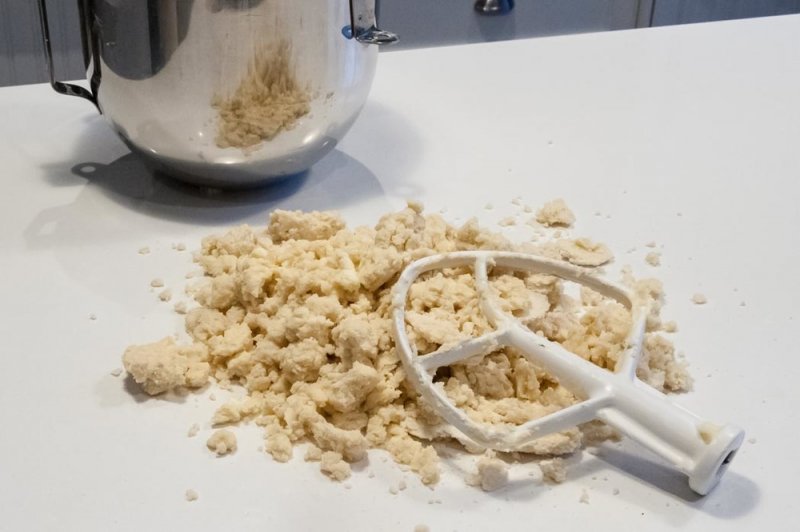
- Use the heel of your hand to smear the dough in a forward direction (this is called fraiser). Starting at the edge of the dough pile, working in small amounts, push the dough forward until you have moved the entire batch. When complete, fold the dough over and repeat until all of the ingredients are completely incorporated. Enjoy this part because it is the charm of this pastry.refrigerate them for at least 2 hours or overnight.
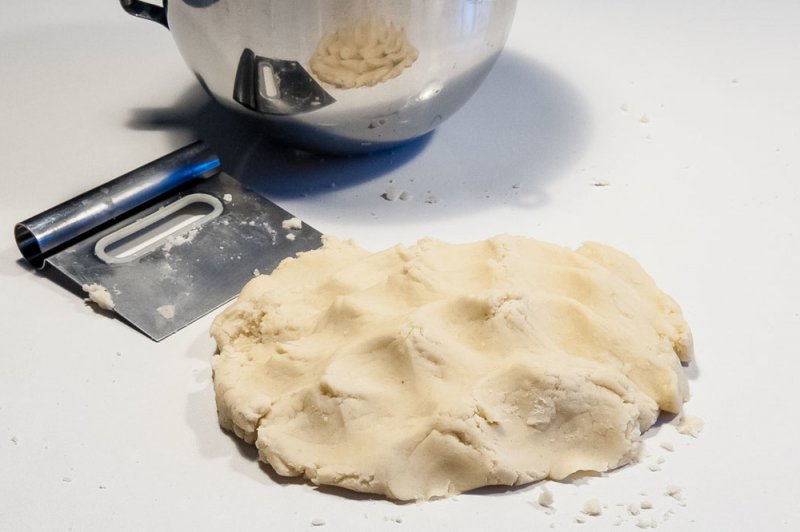
- Divide the dough in half. You will need 325 grams of pastry for the Forentines. It’s important to be precise with this step, since you’ll be using only one of the halves for this recipe, and you won’t want to be short on pastry. With your kitchen ruler, form each half in 4” x 6” rectangles, wrap them in plastic, and refrigerate them for at least 2 hours or overnight.
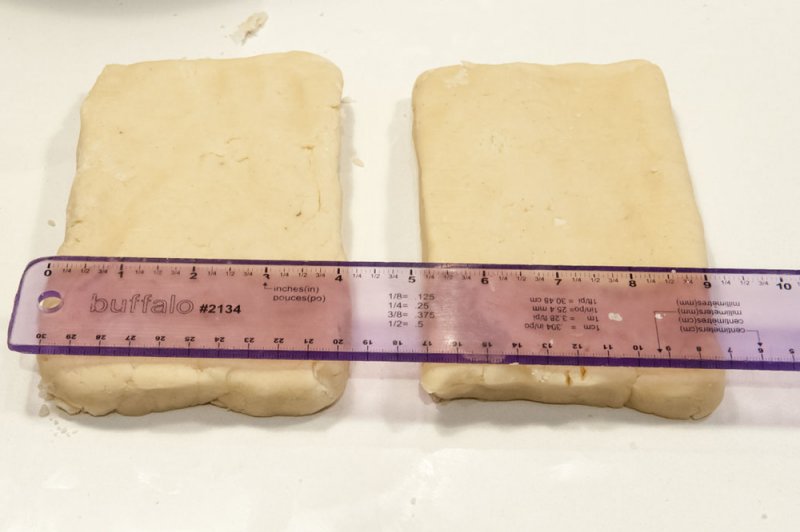
ROLL THE PASTRY
- When ready, unwrap one of the two halves of pastry and place it between two sheets of parchment, 2 sheets of plastic wrap, or on a floured pastry cloth with one sheet of plastic wrap over the top. With your rolling pin, pound the pastry to soften it and begin to roll it into the exact size of your tray (the recommended size here is 10 x 14 inches). The plastic wrap helps keep the pastry from cracking.
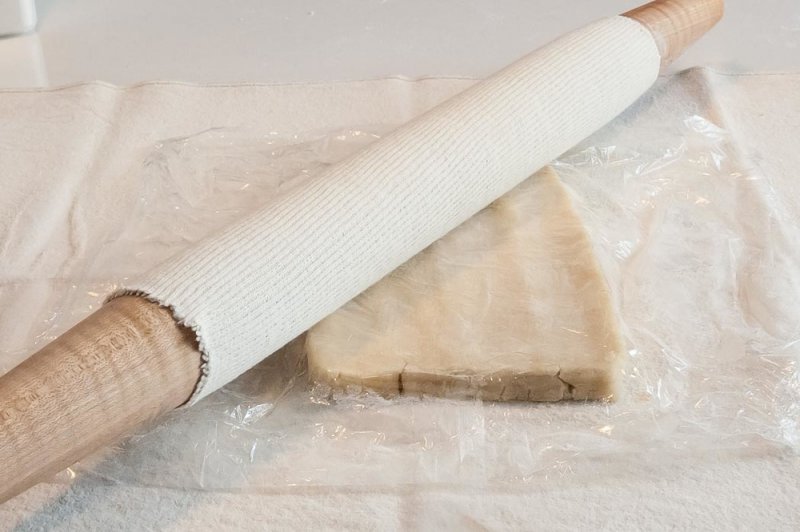
- When you have rolled it to the approximate size, drop the dough into the tray and trim and press it into the missing areas to fill the tray entirely. Try to keep the pastry as evenly distributed in your tray as possible and make sure there are no holes before you bake it.
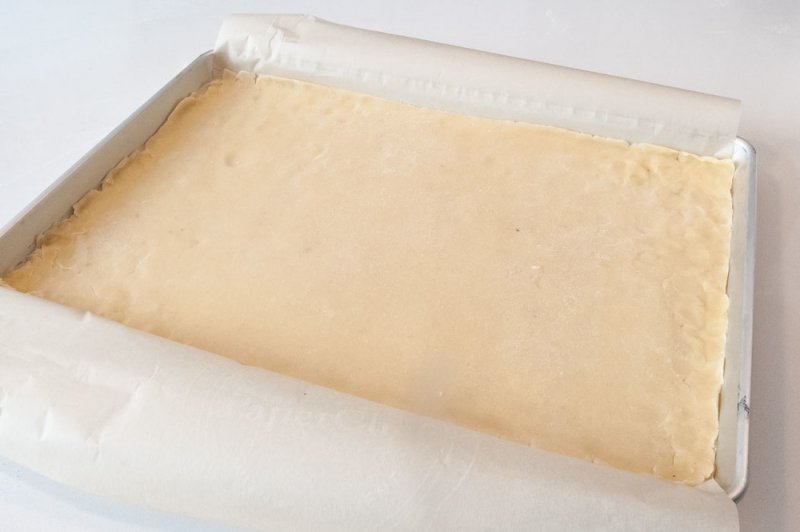
- Freeze the dough for 10 minutes or refrigerate it for about 30 minutes until firm.
BAKING THE PASTRY
- Line the dough with a sheet of parchment and put pie weights or rice (about ½ inch thick).
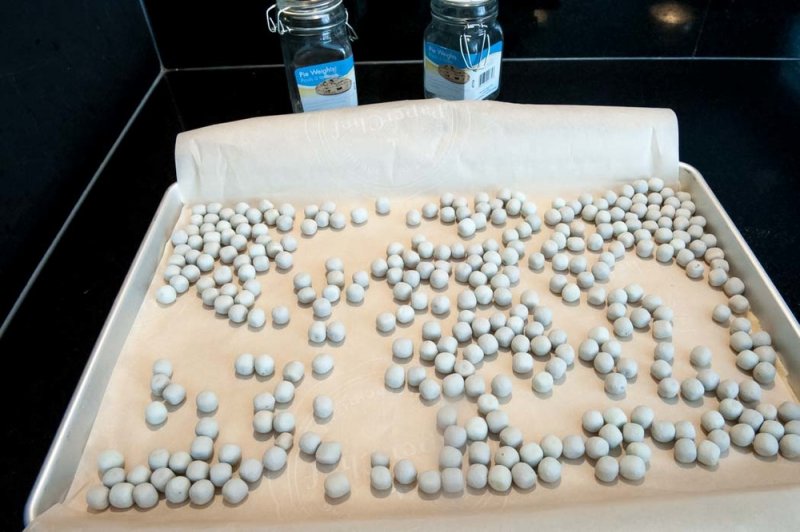
- Put the pastry in a preheated oven (325 degrees). Bake for 10 minutes, turn the tray and bake another 10-15 minutes. It’s important not to over bake the pastry because you will be baking it again with the nut and fruit layer. Bake it until it is just set and very lightly browned. Cool on a rack.
MIS-EN-PLACE
- In a small saucepan, combine whole milk, sugar, glucose and honey and set aside.
- Measure the room temperature butter and set aside
- Set out the salt.
- In a medium bowl, combine the sliced almonds, pistachios and orange peel.
- Ready the candy thermometer and the plastic decorating comb or a metal cake comb
ASSEMBLING THE NUT AND FRUIT LAYER
- Heat the sugars and milk, stirring constantly until everything is dissolved. Using a thermometer, cook for about 8 minutes until the temperature reaches 248 degrees Fahrenheit/120 degrees centigrade. Immediately add the butter and salt, and stir until everything is melted and thoroughly combined. Stir this mixture into the nuts and fruit and spread it onto the crust, using an offset spatula. The mixture will spread very thinly and you might think that you don’t have enough, but you do.
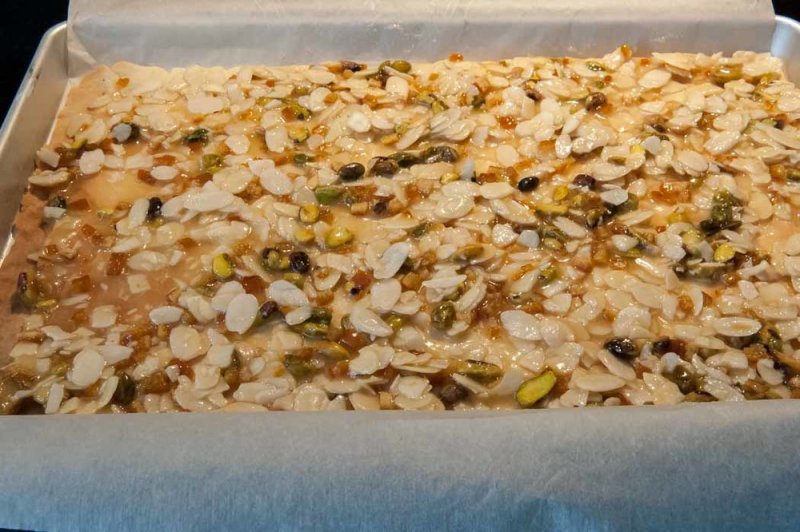
BAKE THE FLORENTINES
- Bake for about 20 to 30 minutes turning the pan around halfway through the baking time. It is done when the caramel is a light, rich golden brown. If you let it go too far (a toasty, dark brown, for example), the Florentine will be too crispy. The goal is golden, rich and chewy looking caramel. You can see in the photo below that the edges darkened a little too much, but the center is the correct color. When it cools, it will have just the right amount of chewy crunch without being too crisp. Watch it carefully towards the end of the baking time to ensure success. This tray got away from me a little bit.
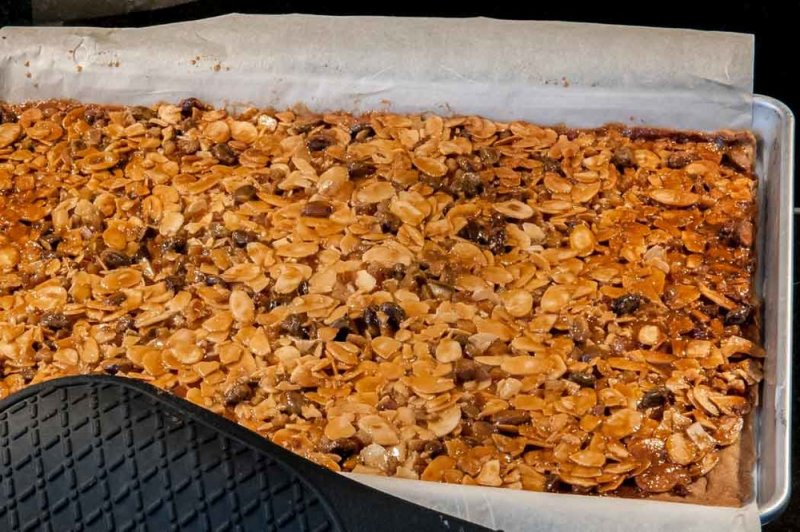
ADDING THE CHOCOLATE
- Melt the chocolate very gently, until it is very smooth. Turn over the Florentine nut-side down, and spread a thin coat of chocolate with your offset spatula over the entire baked side of the pastry. Let it set for a few minutes.
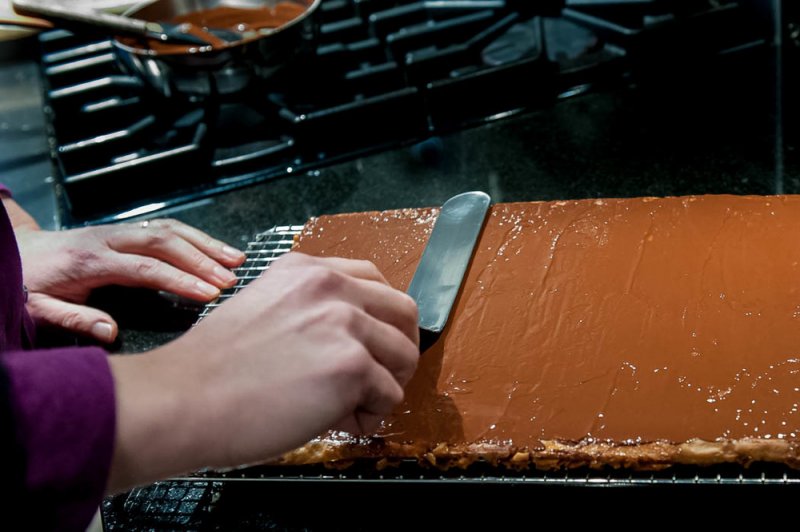
- Then pour the rest of the melted chocolate over the thin coat and spread it evenly over the entire Florentine.
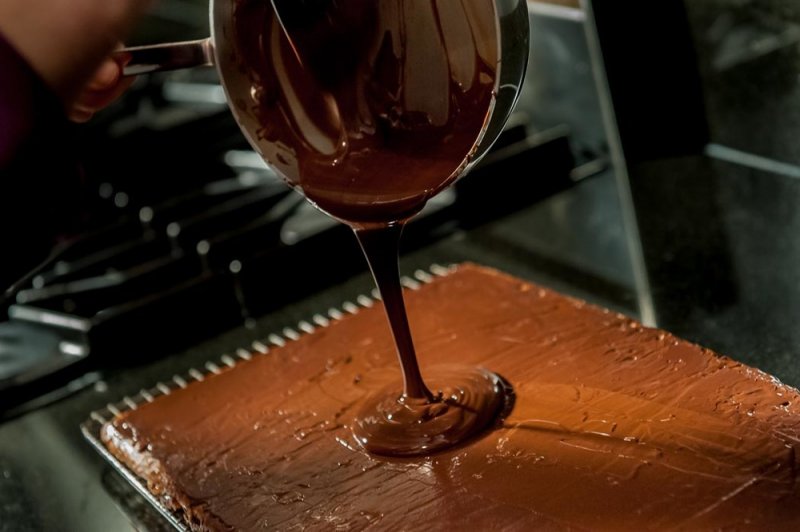
- Then pour the rest of the melted chocolate over the thin coat and spread it evenly over the entire Florentine.
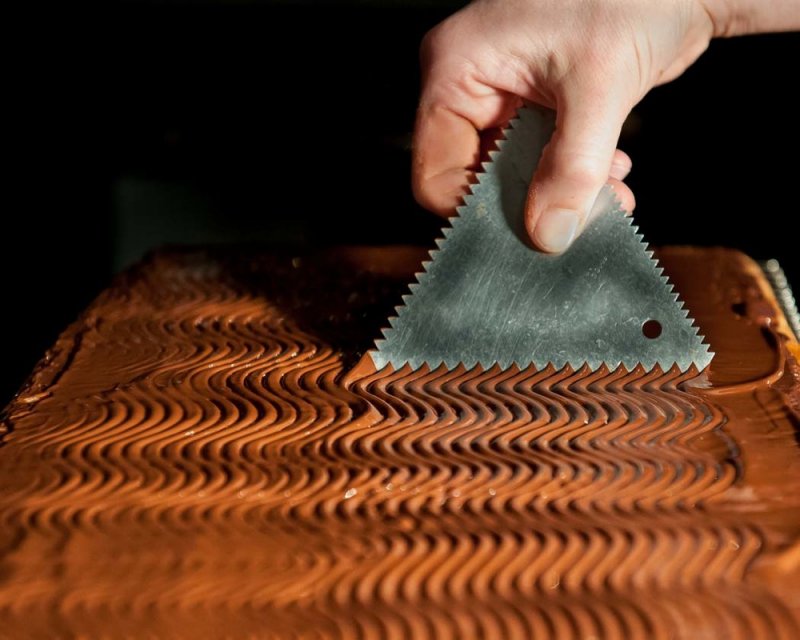
- If you don’t have a comb of any kind, then simply spread the chocolate in a smooth layer and let it set.
FINISHING THE FLORENTINES
- Cut the Florentines in 3” squares, triangles or bars. For myself, I prefer generous 3” squares.
- For further information, consult the original reference: Keller, Thomas and Sebastien Rouxel. “Nougat aux Fruits,” Bouchon Bakery. New York, NY: Artisan, 2012. Pages 54-57.
INGREDIENT NOTES
GLUCOSE: The glucose needed for this recipe is an extremely thick and sticky product. It is easiest to work with when it’s very cold, and with wet or well-greased fingers and fingernails. You might be able to find a small tub of it in a restaurant supply store, or a bakery might be able to sell you a small quantity, or if neither of these options are viable, Wilton sells it in 250 ml containers. A cooking supply store that carries the Wilton product line should have it. While glucose is corn syrup, it isn’t the same commonly known “corn syrup” because what you’ll find on the grocery shelf contains more water than the glucose called for in this recipe.
- Labels
- Chocolate,
- Citrus,
- Nut and Seed
- Tags
- Chocolate,
- Nuts,
- Shortbread
